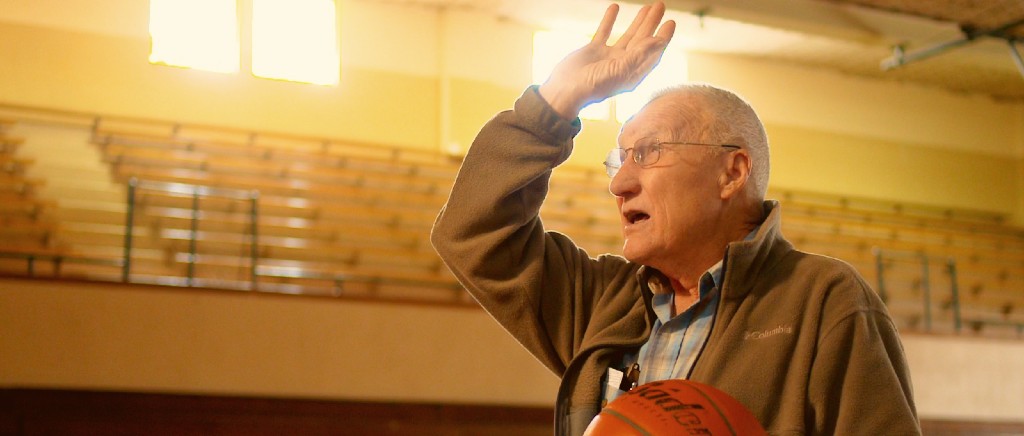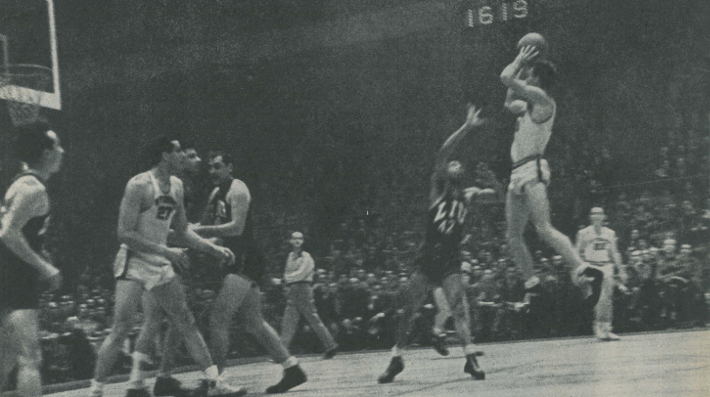
Like many great athletes, Kenny Sailors learned his most valuable lesson about adversity as a child playing against his older brother, Bud, in the backyard. It’s a principle that’s governed the evolution of all life on Earth: Adapt or die.
The older siblings of the world have, historically, been a catalyst for greatness. For Sailors, it didn’t matter how many different ways he tried to score against Bud. He could barely get a shot off without him swatting it away. Bud was taller, stronger, and like many big brothers, an aggressive and implacable foe.
If he was ever going to have a chance, he’d have to rethink his whole approach. He’d have to get crafty, maybe catch him off guard. He’d have to try something he’d never see coming. At the time, he could’ve scarcely realized that it would help revolutionize the game for generations to come.
The new documentary, Jump Shot: The Kenny Sailors Story, chronicles the life and career of the man widely credited with popularizing one of basketball’s trademark moves. During his days at the University of Wyoming and later in the NBA following a tour of duty in World War II, it was Sailors who introduced the jump shot to the popular consciousness.
Steph Curry, who more than a half-century later would go on to become arguably its greatest practitioner, talked about the impact it had on him to discover the history behind the very thing that has defined his life and career and has been second nature to him since he first picked up a basketball.
“Learning the history of where the art of the jump shot came from, who introduced it to the game, and how it changed the game, was incredibly intriguing,” Curry said. “Even more importantly, learning about the person that Kenny was, and what he stood for, was very inspirational.”
To call Sailors the “inventor” of the jump shot is probably a misnomer. Tracing something like that all the way back to its origins with any real certainty would be problematic, bordering on impossible. But there’s little debate that it was Sailors who first brought it center stage, most notably at the NCAA Tournament in 1946 at Madison Square Garden.
During a game between Wyoming and Long Island University, Life magazine photographer Eric Schaal captured the now-iconic image of Sailors, suspended in air above his defender like an otherworldly figure as he rose for shot at the top of the key. It was like a Renaissance painting: an image of mankind reaching for the divine, the sum of all human endeavors captured in the airspace between his feet and the hardwood below. Like the hosts in Westworld gazing at a futuristic city-scape, no one was quite sure what they were looking at.

In the modern NBA, there are so many things we take for granted: the 24-second clock, the three-point line, the slam dunk, the three-second rule. It’s hard to conceive of a time when none of these things existed, to wrap our heads around the idea that someone essentially had to invent them. It’s equally difficult to overstate their impact on the sport.
Today, the jump shot is a primary weapon in every basketball player’s arsenal. It’s deeply encoded in the game’s cellular blueprint. But watching the archival footage of Sailors in action during his era brings the early novelty of it into stark relief. In terms of shot mechanics, it skipped right past the larval stage and emerged fully-realized his textbook form, perfected as it was in the obscurity of the Big Sky Country of the American West.
The film itself is a goldmine of archival material from that time, charting Sailors’ playing career from his days in Wyoming through several stops along his NBA journey. It’s a massive cache of footage that, to the layperson, seems like it would be a documentarian’s dream.
“Or a nightmare,” Director Jacob Hamilton said, somewhat jokingly. “Whichever way you want to look at it.”
The footage wasn’t easy to acquire. Hamilton and his crew had to piece it together from the University of Wyoming archives, from miscellaneous sources they tracked down online, and somewhat unexpectedly, from Sailors’ own son, who had reels of 8mm film that had been sitting in his attic for years. The result is a stunning time capsule of the game at a pivotal moment of its evolution and the figure who was at the center of it.
In it, Sailors exhibits all the hallmarks of the modern game. And not just the jump shot. His crossover has seeds of Allen Iverson. His flair for passing predates Magic and Pistol Pete. He’s aggressive, attacking in the open court like a Russell Westbrook prototype. It’s like watching a modern player who traveled back in time.
“You hear all the stories, which I had already heard because we’d sat down with Kenny,” Hamilton said. “But to actually see it unfold in front of you with your own eyes and see what he was doing then, you marvel at it.”
Don’t take Hamilton’s word for it. As part of the project, he showed the footage to several of today’s stars, all of whom were awed by how ahead of his time Sailors was.
“Kenny was a master,” Dirk Nowitzi said. “The impressive thing is how high he jumped. Some guys shoot jump shots now, but they shoot more like, little hops, or you know, you don’t really jump full-on. And so he’s like, the elevation is just incredible. I mean, it really looks like a Russell Westbrook pull-up now. The way Kenny elevates and stops on a dime on the break, I mean, that’s amazing. That’s the full-on jump. That’s not a lot of guys actually do that now. That’s impressive.”
Along with Nowitzki, Hamilton screened the film for several current stars. He wanted to bring in younger voices from around the league to add clout and to help frame Sailors’ unique accomplishments in their proper context. At one point during the viewing with Kevin Durant, Hamilton said that Durant paused the film, eager to explain how during practice, he’d watched Curry working on one of Sailors’ exact moves.
“[Sailors] made a move going left, and he stopped on the dime and shot off one leg, and I’ve seen Steph do the same shot at practice,” Durant said. “And I was like wow, that’s so amazing that, half a century later, that the greatest shooter to ever to play the game could be influenced by Kenny, and he doesn’t even know Kenny, you know?”
***
The truly outstanding documentaries — the ones that transcend their subject matter, that get under your skin and stay there long after the closing credits — often start out as one thing and end up as something else entirely. It takes a willingness on the filmmaker’s part to let the subject guide the storytelling, to follow it down its winding paths, to find the real story that wants to be told. It’s an exercise in trust. In this case, it was a matter of rescuing the human being from the dark cave of a historical footnote.
In 2010, Hamilton was searching for his next film project when he came across a quick two-minute video about the origin of the jump shot, which featured an interview with Sailors. As a lifelong sports fan, he was immediately enthralled. Like most of us, Hamilton had always taken the jump shot for granted. It never occurred to him that it hadn’t always existed, that someone had to introduce it to the wider world. But that was only part of what drew him in.
“Kenny was an absolute character in this two-minute interview,” Hamilton said. “and then I began to do a little bit more research on who he is: what did he do, why don’t I know this guy? I just started uncovering all these small stories where I was like, wow, this guy lived this extraordinary life. Maybe there’s something bigger here than just a short origin story about the jump shot.”
Sailors and his easy charm are ubiquitous throughout the film. He is a grandfatherly figure, whose warmth, humor, and benevolence shine through each frame. But it’s the film’s third act that adds so much texture to his story by sharpening its focus on the man behind the jump shot — the mentor, homesteader, and part-time politico who carved out an unconventional path later in life that was arguably as meaningful as anything he did on the court.
After he retired from basketball, Sailors moved to Alaska with his wife, where he would live off the land and become a pioneering figure for girls’ basketball in the state, particularly native girls, who had previously not been allowed to participate in team sports. At its core, the film is as much about honoring those contributions as it is an effort to secure his rightful place in basketball history.
Sailors’ legacy is undeniable.
